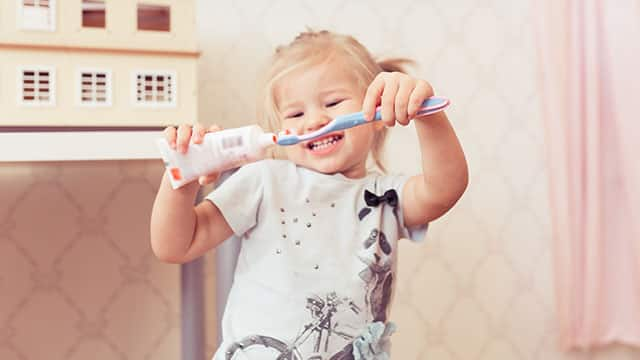After reviewing all the available evidence on toothpaste for children, the American Dental Association (ADA) has created a set of guidelines to help answer this question. Let’s take a look at the recommendations and explain some of the key points.
When to Start Brushing
Just like adults, children are susceptible to tooth decay. Did you know that according to the ADA, 25% of children have a cavity by the time they enter kindergarten? It's no wonder you want to help your child with their oral care routine as soon as possible. As soon as your child's teeth come in, which usually begins around six months of age, you should be consistent about brushing them with a fluoride toothpaste.
What Does Fluoride Do?
Fluoride is a naturally occurring mineral that’s essential for strong, healthy teeth. It’s added to the public drinking water supply in many areas, and is also a common ingredient in most kinds of toothpaste. If your local water supply doesn’t contain fluoride, it’s especially important that your child uses a fluoride toothpaste in order to get enough of this vital mineral.
Using Age-Appropriate Amounts of Toothpaste
The ADA's new guidance for children under three years of age is to brush using a "smear" of fluoride-containing toothpaste, no larger than a grain of rice. You should brush their teeth twice a day, once in the morning and once at night. When your child turns three, the ADA recommends that you continue brushing your child's teeth twice a day, now using a pea-sized amount of fluoride toothpaste.
Choosing the Right Toothbrush Size
Beyond finding the right toothpaste, the size of your child's toothbrush also matters. By getting a toothbrush that's the appropriate size for a child's mouth, as well as one that's colorful, or plays music, or even lights up, you'll be helping to make brushing fun, comfortable and effective for your child! It's also helpful to check with your child's dentist or dental hygienist when choosing these products since they're professionals who also know your child well.
Supervising Your Child
You should brush your child's teeth for them until they're about six or seven, as they will lack the necessary coordination to do a thorough job. Once they’re able to brush independently, you’ll still need to supervise to make sure they’re brushing properly and for long enough. It’s also important to make sure they’re not swallowing any toothpaste, as excessive intake of fluoride can lead to fluorosis, a cosmetic defect in the tooth enamel. Encourage them to spit after brushing and explain how important it is that they don’t swallow or eat toothpaste.
Look for the Seal of Acceptance
Look for a toothpaste that has the ADA Seal of Acceptance®. It's an excellent source of confidence for parents and caregivers, confirming that the toothpaste is safe and effective for their kids.
Making the right pediatric dental choices comes down to having the correct information. Armed with the ADA's recommendations, you should feel confident that you're giving your child the best pediatric toothpaste that's appropriate for their age. You should always feel comfortable bringing up any dental product concerns with your child's dentist and dental hygienist too. This will ensure you feel empowered to make the best decisions for your child's oral health and supervise them with confidence!
Frequently Asked Questions About Toothpaste Guidelines for Children
What are the toothpaste guidelines for young children?
Children under three should use a smear of fluoride toothpaste, no larger than a grain of rice, while children aged three and older should use a pea-sized amount.
When should children start using fluoride toothpaste?
Children can start using fluoride toothpaste as soon as they get their first tooth. However, parents should choose an age-appropriate toothpaste and use no more than recommended.
What should you do if your child ingests fluoride toothpaste?
You should discourage your child from swallowing toothpaste and supervise to make sure they spit after brushing to avoid the risk of fluorosis. If your child does swallow after brushing or eats a little bit of toothpaste, though, don’t panic. Small amounts of fluoride are not toxic, although your child might have a mild stomach upset for a little while afterwards. If your child swallows a large amount of fluoride toothpaste, call Poison Control on 1-800-222-1222 for advice.
Are there alternative toothpaste options for children who may be sensitive to fluoride?
If your child is sensitive to fluoride, speak to your dentist about alternatives. They can recommend safe and effective products and give you advice on how to protect your child’s teeth from decay in the absence of fluoride.
Oral Care Center articles are reviewed by an oral health medical professional. This information is for educational purposes only. This content is not intended to be a substitute for professional medical advice, diagnosis or treatment. Always seek the advice of your dentist, physician or other qualified healthcare provider.
ORAL HEALTH QUIZ
What's behind your smile?
Take our Oral Health assessment to get the most from your oral care routine
ORAL HEALTH QUIZ
What's behind your smile?
Take our Oral Health assessment to get the most from your oral care routine















